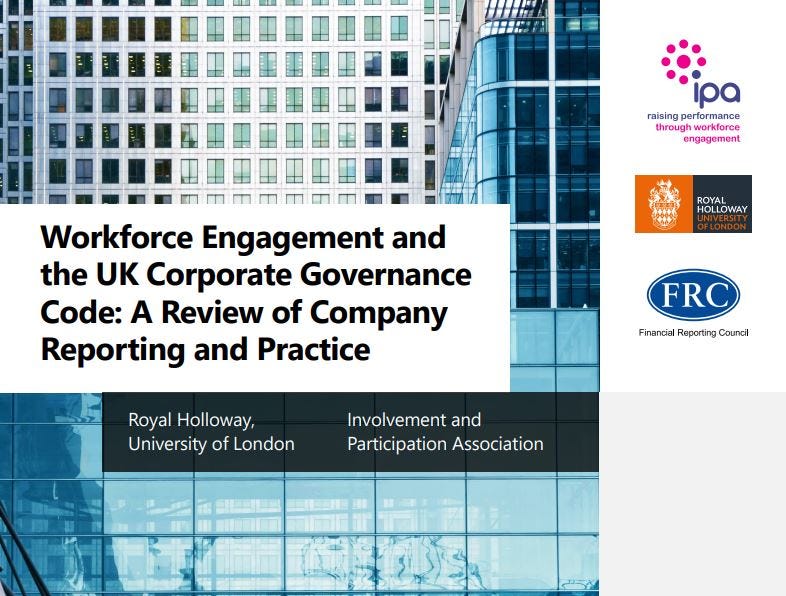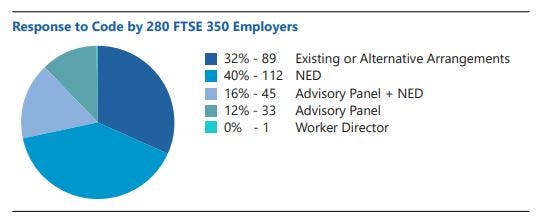How have companies responded to changes in the Corporate Governance Code and what does that tell us about the state of employee engagement?

Successive UK governments have made a priority of employee engagement. This has involved task forces and reports, and in 2018 it included revising the Corporate Governance Code of the Financial Reporting Council (FRC).
If you’re not familiar with it, the code is part of UK company law. First established in 1992, it sets out standards of good practice for listed companies who have to either “comply or explain”.
When the code was updated in 2018, it included for the first time a specific requirement for boards to ensure there is effective workforce engagement.
What does this mean? To quote from the guidance that accompanies the code: “Engagement through a range of formal and informal channels helps the workforce to share ideas and concerns with senior management and the board. It provides useful feedback about business practices from those delivering them, and can help empower colleagues.”
This may sound bland, but it’s indicative of an important shift whereby boards are more on the hook for culture, engagement, and people issues in general. This rightly reflects a sharper focus on human capital and the contribution of intangibles to business success.
It’s worth noting that the FRC will soon become the Audit, Reporting and Governance Authority (ARGA) — with the aim of being a stronger regulator. It’s likely that workforce and stakeholder engagement, along with environmental and social responsibility, will continue to grow in importance.
In practical terms, the updated code stated that companies should use one or more of the following methods:
- A Non-Executive Director (NED) who is on point for engagement issues
- A workforce panel to provide advice to board members
- An employee director who is appointed from the workforce.
There was a loophole. Companies can opt for “alternative arrangements” as long as they can show they’re effective.
The revised code came into operation in January 2019. Our research at that time indicated that companies were not in a rush to do anything major. The most likely option was the first one — not surprisingly, the easiest.
Companies have now had a period of time to respond and a very useful report has come out that provides a clear picture of what’s been done.
The report is by Chris Rees and Patrick Briône who collected feedback from 280 of the companies in the FTSE 350.

The report shows that, as predicted, most companies have taken the easier option. In fact, most firms describe the changes they have made as an evolution of what they were already doing.
According to the study, 40% of companies have appointed a NED, 12% have established an advisory panel, and 16% have appointed a NED in combination with setting up an advisory panel. Only one company has installed a director appointed from the workforce (joining four firms that already had them).

Others have adopted alternative approaches instead. These have mostly been listening activities, such as focus groups, informal conversations with employees, and engagement surveys.
This confirms my experience, that the code has breathed new life into engagement surveys. Even though their demise has long been predicted, engagement surveys are actually having a bit of a renaissance.
Even when a NED has been appointed, engagement surveys feature prominently in their remit. According to the study, “Many firms report the role of the NED as being to ‘complement the engagement survey’, with the NED responsible for the provision of feedback to the board on the results.”
Other NED activities include:
- Site visits
- Town halls
- Meeting with small groups of employees
- Focus groups
- Reviewing messages received through the whistle-blowing system
NEDs come from a range of backgrounds, but mostly general management. Around 1-in-5 have worked in HR previously. Half of NEDs had no specific experience of workforce engagement prior to their appointment. The report’s authors note that the process for appointing NEDs is very unclear.
When it comes to advisory panels, they meet at least twice a year. Someone from the board or from management (usually the HR director) attends and often chairs the meetings. They then give a formal report back to the board.
Panel discussions cover a wide range of topics, such as:
- Flexible working
- Mental health and well being
- Workplace facilities and working environment
- Strategy, purpose, culture and values
- Diversity and inclusion
- Career development
- Pay and bonuses
- Climate change and sustainability
Again, according to the study, engagement surveys feature prominently in panel discussions: “There is an emphasis on panels supporting engagement surveys, with firms referring to panels providing ‘valuable input into action plans’ following annual survey results.”
In terms of who is on these panels, the most common approach is management appointees from different functions and business units. They are often nominated by line managers; not chosen by employees.
The least popular option — by far — is employee directors. This is despite the fact that it was a much-trumpeted idea in the discussions that led up to the revised code’s launch.
One firm with employee directors is Capita. According to reports, nearly 400 colleagues applied to take on one of two director roles, which “pay £64,500 a year on top of their day job’s salary.” Two long-serving employees were appointed in 2019 and put through training on topics such as investor relations. According to the CEO, Jon Lewis, the employee directors provide an “unvarnished view of the operational and strategic challenges facing the company.” As one of the employee directors themselves put it: “I think we’ve raised things that would not otherwise have been discussed in a boardroom.”
Standing back from the specific arrangements, what’s also notable is how companies have gone about deciding on their approach to workforce engagement in the first place. As the report points out: “In the vast majority of cases, the workforce themselves were not involved in the decision regarding how the firm responded to the code. This is itself an indication of a lack of workforce voice in strategic discussions.”
So what does all this tell us about the state of employee engagement?
Of course, the last year has been far from normal. The pandemic has impacted all aspects of organisational life. Companies that were slow off the blocks have not been able to make up lost ground.
Keeping this in mind, here are three observations:
- A significant rump of firms are doing close to the minimum. Effectively, they’re complying, so they don’t have to explain. The report is a reminder that there is still this low-maturity group of companies in the UK, doing as little as possible and only because they have to. The code is designed to drive improvement in this long-tail over time. That’s a good thing, as these organisations are under-prepared in terms of how they enable their talent, drive transformation, and remain competitive in the future.
- Further along the maturity curve are companies that are trying new things. They are placing more emphasis on employee feedback and involving people in changes. This shift is key. A stronger focus on employee voice is positive, but it needs to be part of a more strategic approach to employee experience activation. I have written elsewhere about how co-creation and involvement are at the heart of how you go about building a high-performance EX. It’s positive that a good number of organisations are already taking steps in this direction.
- Leading organisations are already far ahead of the pack. Moreover, the distance from the rump group to best-in-class firms is staggering. They are operating in different worlds. In mature, employee-intelligent organisations, feedback is translated from moment-in-time insights into a deep understanding of critical talent and the employee life cycle. HR takes a design-thinking approach to activating employee experience. This means maximising the value of key episodes and moments. They do this through prototyping and testing, from learning what’s working well and what’s not, and through rapid iteration. People managers understand their role in delivering experiences that build trust in the future.
So how will things develop from here?
The report suggests that the UK government will continue to champion employee engagement. It’s still a hot topic, as it connects many different areas that are seen as critical to the future of work.
From the government’s perspective, workforce engagement also provides a comfortable compromise, since it encourages stakeholder involvement without supporting direct worker representation.
The report’s authors themselves highlight the power of providing feedback directly to board members, so they can, in turn, make company management more accountable.
As a result, they predict the regulator will get more teeth: “As the FRC transitions to becoming a new regulator — the Audit, Reporting and Governance Authority — it may receive further powers. Demands are likely to grow for companies to give greater priority to long-term sustainable business models which incorporate employee interests.”
If you want any advice on employee engagement strategies and how to create a world class approach to employee experience, please get in touch.